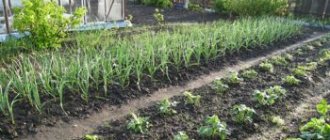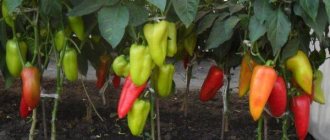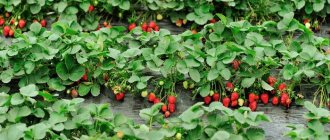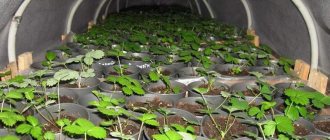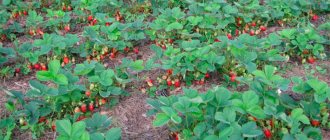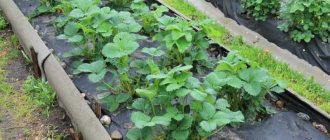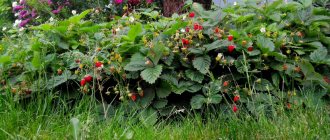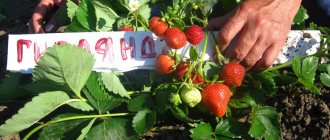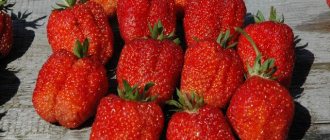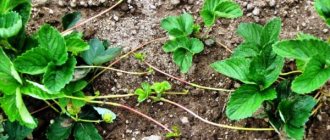Soil for strawberries
Strawberries grow successfully on any well-fertilized soil, but prefer light loam and sandy loam, as well as cultivated grassy peat soils and deep arable layer.
Sandy soils are also suitable if they are provided with sufficient humus and moisture. They warm up faster, as a result of which they accelerate the ripening of berries. The subsoil layer must be permeable, the depth of groundwater should be no closer than 0.7-0.8 m from the surface of the earth. Strawberries grow better in slightly acidic soils. Strawberries do not tolerate moist, heavy alkaline and swampy soils with high groundwater levels.
It should be taken into account that certain varieties of strawberries have special requirements for the soil.
Site and soil preparation
Well-protected light areas with deeply cultivated, loose and breathable soil are suitable for strawberries. The site should be as flat as possible or with a slight slope (no more than 5°). In wetlands, diversion ditches are made and soil is added.
Strawberries are grown on all soils, but the best soils for them are medium loamy soils. Clay and sandy soils should be fertilized with manure and compost. It grows relatively well on soils where the pH is not lower than 5.0, but it is better on slightly acidic soils with a pH of 5.5-6.0.
Acidic soils (pH 5.0 and below) are limed, gradually increasing the depth of the arable horizon with the obligatory application of organic fertilizers (in the form of composts) or green fertilizers (incorporation of green manure crops). On soils where the pH is above 6.0, peat, gypsum, mineral fertilizers, and a weak solution of hydrochloric acid are applied.
Pre-planting soil preparation includes: digging with a full shovel, selecting and removing the rhizomes of perennial weeds, applying fertilizer evenly over the area, thoroughly leveling the soil surface, and marking the area.
No additional fertilizer should be added to soil that has been well cultivated and fertilized in previous years. On poor soils, the best predecessors of strawberries are green manure crops (mustard, phacelia, etc.), which are incorporated into the soil during the flowering period; the same effect is achieved by introducing plant residues from young weeds, etc. All soil preparation work must be completed 7-10 days before planting the strawberries.
Choosing a place for strawberries
The most suitable for strawberries are elevated, flat or with a slight slope (southern, south-western or eastern) areas, illuminated by the sun, with strips of trees and shrubs for protection from cold winds, especially for early ripening varieties, areas with a slope to the south, however for southern regions this is not recommended due to possible drought and heat.
In low areas, during spring frosts, cold air accumulates and plants often freeze out. In micro-depressions in which the perennial water stagnates, the strawberries become soaked.
In the southern regions, strawberries grow better in low-lying areas that are well moistened and protected from the winds.
It is possible to place strawberries in the rows of an orchard (it is better to refuse this), but so that their rows are no closer than 1-1.5 m to the trunks of fruit-bearing trees.
New plantings should not be adjacent
with old strawberries, raspberries, since the raspberry weevil is a common pest of them.
If possible, strawberry fields should be selected close to the estate.
Unwanted Precursors
Garden strawberries are not recommended to be planted in places where the following plants previously grew:
- potato;
- tomatoes;
- Bell pepper;
- pumpkin (melon, pumpkin, watermelon, cucumbers, zucchini);
- eggplant;
- all varieties of cabbage;
- berry crops;
- sunflower;
- asters, gladioli, lilies;
- sunflower;
- chrysanthemums, roses.
Before planting bushes, it is necessary to add organic matter and complex fertilizers to the soil. It is also very important to fertilize and treat the soil against pests and plant diseases.
Predecessors of strawberries
The best predecessors of strawberries
The best predecessors of strawberry green manure are considered to be mustard and rapeseed. They release substances into the soil that are toxic to nematodes, fungi, and a number of weeds. Also, before planting strawberries, other green manures, such as oats or barley, are grown in the beds to a height of 15-20 cm. Then they are buried to a depth of 10-15 cm.
Good predecessors, especially on poor soil - black fallow, green manure - lupine (both annual and perennial), legumes, phacelia, oats, clover, a mixture of cereals, legumes and perennial grasses. Other plants are also suitable for green fertilizer, for example, calendula (marigold), marigold, nasturtium. They even disinfect the soil to some extent.
Good predecessors of strawberries are vegetables such as beans, peas, beans, garlic, radishes, celery, carrots, turnips, corn, green crops (radish, parsley, dill, spinach), medicinal herbs (calendula, black-browed grass).
Acceptable predecessors of strawberries
Acceptable predecessors of strawberries: beets, lettuce, onions, garlic, radishes, parsley, peas, beans, beans, carrots, radishes, radishes, celery, dill, spinach, corn, turnips, green manure. medicinal herbs (calendula, Chernobrivtsy)
Inadmissible predecessors of strawberries
Not allowed as predecessors
crops (since they have diseases and pests in common with strawberries) such as potatoes, tomatoes, peppers and other nightshades.
Also undesirable are
cucumbers, cabbage, plants of the asteraceae family - (asters, lettuce, chicory, romaine, tarragon) and ranunculaceae (nigella).
As a last resort, in the year of autumn planting of strawberries, an early intermediate crop
(lettuce, radishes, spinach, dill, etc. are sown).
Problematic “neighbors” of strawberries in crop rotation - what should not be planted before strawberries
Vegetables and flowers of the Solanaceae family
These include:
- tomatoes, peppers, eggplants;
- potato;
- nightshade, physalis;
- fragrant tobacco;
- datura (datura);
- schisanthus (schizanthus);
- petunia.
They, like strawberries, can become infected with fungal diseases - fusarium, late blight and verticillium wilt. Such infections accumulate in the ground. Crops also have common viral diseases.
Asters, lilies, gladioli
These flowers and strawberries have the same pest - the stem nematode.
Dahlias, cauliflower
They may suffer from wilt (verticillium wilt).
More on the topic: Strawberries on the windowsill
Vegetables of the pumpkin family
We are talking about cucumbers, zucchini, pumpkins, and melons. Like strawberries, they can be affected by wilting diseases through the root system.
Fruit and berry bushes and trees
You cannot plant strawberries after:
- raspberries;
- currants;
- gooseberries;
- cherry, plum, peach, apricot.
Remains of roots decomposing in the ground after uprooting provoke the development of rot in the root system of strawberries. Plums and peaches can leave behind an infection in the ground such as verticillium wilt. Areas under raspberry trees can be inhabited by raspberry-strawberry weevils and botrytis spores (gray fruit rot).
How you can feed raspberries at different times of the year, read here
Legumes
Vegetables, flowers and green manure from the Legume family:
- beans, beans, peas;
- clover, alfalfa, sweet clover;
- vetch, seradella, sainfoin;
- lupine.
These plants are considered excellent predecessors for most crops. And strawberries would be no exception. But legumes sometimes act as intermediate hosts for a dangerous pest - the strawberry nematode. There is also a common disease with strawberries - late blight wilt.
Beet
The popular root vegetable is related to strawberries by a fungal infection - fusarium wilt, which penetrates plants through the roots.
Late and mid-season cabbage
This group includes autumn varieties of cabbage varieties such as white, red, Savoy, and Brussels sprouts. They greatly deplete the soil, “pumping” a lot of nitrogen and potassium out of it.
Crop rotation with strawberries
Strawberries can be grown in one place for no more than 3-4 years. Strawberries can be planted in the same place no earlier than after 3-5 years. Typically, strawberries are included in vegetable or field crop rotations.
In the year of planting strawberries, until the end of July, green manure (mustard, rapeseed) or early ripening vegetable crops can be grown on the future plantation. In the year of plantation liquidation, starting from mid-July, vegetables can be grown or green manure (mustard, rapeseed) can be sown.
As an example, below is a plan for a six-field crop rotation for growing a two-year crop of strawberries and vegetables.
Varieties of strawberries (garden strawberries)
Varieties of strawberries (garden strawberries): Krasavitsa Zagorya, Zarya
Varieties of strawberries (garden strawberries): Rubinovaya, Festivalnaya
Varieties of strawberries (garden strawberries): Zenga zengana, Talisman
The most popular variety of strawberries (garden strawberries): Ruby pendant
Year 1
Field 1
Strawberry, 2nd year of fruiting. After its elimination, starting in mid-July, plant late vegetables before winter or sow green manure - mustard, rapeseed, oats, barley.
Field 2
Growing winter vegetables, or burying green manure and sowing vegetables that are undemanding to manure - these are carrots and other root vegetables (radishes, turnips, radishes, parsnips, beets, kohlrabi, parsley, oat root and scorzonera), kale, valerian, dill.
Field 3
Add manure to the soil in winter and early spring, or compost (as much as you can). Growing vegetables that love manure, such as cucumber, zucchini and other pumpkins, celery, garlic, leeks.
Field 4
Growing vegetables that do not require manure are carrots and other root vegetables (radishes, turnips, radish, parsnips, beets, kohlrabi, parsley, oat root and scorzonera), kale, valerian, dill.
Field 5
Growing early vegetables, these are early bel-koch cabbage, cauliflower and kohlrabi, summer radish, bunched turnips, carrots and celery in bunches, leaf and head lettuce, watercress, peas (harvesting of green beans and shelling peas begins in central Russia and Belarus in the second half of June - early July), onions, beets (when harvesting early beets in the first ten days of July), lettuce (30-40 days after germination), radishes, parsley, dill, spinach. Or sowing green manure - mustard, phacelia, lupine, mustard, oats. After harvesting, planting strawberries. When planting, add ash or phosphorus and potassium fertilizers to the soil (or at least to the holes).
Field 6
Strawberry, 1st year of fruiting.
Pre-planting soil mulching
Mulching the soil increases the yield of strawberries by 30-35%, accelerates the ripening of berries by 3-5 days, reduces damage to berries by gray rot, and preserves soil moisture. You can mulch the soil with various light-proof materials: dark film, special germ-protective paper, roofing felt, etc.
Mulch material 60-120 cm wide is spread on a carefully prepared, leveled and well-moistened soil surface (possibly on low ridges). The edges of the mulch strip (10-15 cm) are secured with soil or pinned with metal staples. Then holes with a diameter of 5-7 cm or cross-shaped cuts of the same length are made in the mulch in accordance with the accepted plant placement pattern.
Between the strips of mulch with plants, you can spread strips of roofing material 30-40 cm wide for the period from spring until the end of fruiting of strawberries (garden strawberries). This prevents the growth of weeds between the rows and reduces the evaporation of moisture from the soil surface. Mulch material can also be spread under already planted plants.
Year 2
Field 1
Growing winter vegetables, or burying green manure and sowing vegetables that are undemanding to manure - these are carrots and other root vegetables (radishes, turnips, radishes, parsnips, beets, kohlrabi, parsley, oat root and scorzonera), kale, valerian, dill.
Field 2
Add manure to the soil in winter and early spring, or compost (as much as you can). Growing vegetables that love manure, such as cucumber, zucchini and other pumpkins, celery, garlic, leeks.
Field 3
Growing vegetables that do not require manure are carrots and other root vegetables (radishes, turnips, radish, parsnips, beets, kohlrabi, parsley, oat root and scorzonera), kale, valerian, dill.
Field 4
Growing early vegetables, these are early bel-koch cabbage, cauliflower and kohlrabi, summer radish, bunched turnips, carrots and celery in bunches, leaf and head lettuce, watercress, peas (harvesting of green beans and shelling peas begins in central Russia and Belarus in the second half of June - early July), onions, beets (when harvesting early beets in the first ten days of July), lettuce (30-40 days after germination), radishes, parsley, dill, spinach. Or sowing green manure - mustard, phacelia, lupine, mustard, oats. After harvesting, planting strawberries. When planting, add ash or phosphorus and potassium fertilizers to the soil (or at least to the holes).
Field 5
Strawberry, 1st year of fruiting.
Field 6
Strawberry, 2nd year of fruiting. After its elimination, starting in mid-July, plant late vegetables before winter or sow green manure - mustard, rapeseed, oats, barley.
Dates and patterns for planting strawberries (garden strawberries)
There is a general rule : the earlier the plants are planted, the better development and larger harvest should be expected from them next year. Autumn planting of strawberries must be completed before September 5, otherwise there may be poor survival of seedlings, death in winter and greater thinning in the first year.
Single- and multi-line planting schemes are suitable for strawberries. To obtain seedlings, mother plants are planted according to one- and two-line schemes. Such schemes are also used when planting a site without mulching the soil, when seedlings take root in the rows.
from the mother plot only for one year. In the next two years, berries can be grown in this area.
In the area intended for producing berries, plants are planted in a three- or five-line pattern. With this placement, the next year after the first harvest, the plants in the middle rows can be removed (cut) in order to provide better conditions for fruiting in subsequent years. In the vacant spaces, annual vegetable or flower crops can be grown as a compactor: radishes, head lettuce, turnips, cabbage, onions, garlic, tulips, etc.
Strawberry planting schemes (garden strawberries)
For multi-line plantings, weakly leafy varieties are better suited: Krasavitsa Zagorya, Early Maheraukha, Redcoat, Redgauntlet.
Densely leafy varieties that are prone to severe damage to berries by gray rot (Zenga Zengana) should be placed with large distances between plants.
Year 3
Field 1
Add manure to the soil in winter and early spring, or compost (as much as you can). Growing vegetables that love manure, such as cucumber, zucchini and other pumpkins, celery, garlic, leeks.
Field 2
Growing vegetables that do not require manure are carrots and other root vegetables (radishes, turnips, radish, parsnips, beets, kohlrabi, parsley, oat root and scorzonera), kale, valerian, dill.
Field 3
Growing early vegetables, these are early bel-koch cabbage, cauliflower and kohlrabi, summer radish, bunched turnips, carrots and celery in bunches, leaf and head lettuce, watercress, peas (harvesting of green beans and shelling peas begins in central Russia and Belarus in the second half of June - early July), onions, beets (when harvesting early beets in the first ten days of July), lettuce (30-40 days after germination), radishes, parsley, dill, spinach. Or sowing green manure - mustard, phacelia, lupine, mustard, oats. After harvesting, planting strawberries. When planting, add ash or phosphorus and potassium fertilizers to the soil (or at least to the holes).
Field 4
Strawberry, 1st year of fruiting.
Field 5
Strawberry, 2nd year of fruiting. After its elimination, starting in mid-July, plant late vegetables before winter or sow green manure - mustard, rapeseed, oats, barley.
Field 6
Growing winter vegetables, or burying green manure and sowing vegetables that are undemanding to manure - these are carrots and other root vegetables (radishes, turnips, radishes, parsnips, beets, kohlrabi, parsley, oat root and scorzonera), kale, valerian, dill.
Planting strawberry seedlings (garden strawberries)
The quality of planting affects the survival rate and subsequent growth of plants. When planting in a hole (hole), the roots of the seedlings are lowered and straightened so that they do not bunch up and bend their ends up. Then the roots are evenly distributed and the hole is filled, compacting with soil in two or three steps, avoiding any voids near the roots. In this case, you need to ensure the correct planting depth: the apical bud (heart) should be at the level of the soil surface.
potted seedlings : insert a pot into the hole, compact it with soil, observing the correct planting depth.
Planting strawberry seedlings (garden strawberries)
When using not fully developed (weak) seedlings, as well as to quickly obtain multi-horned bushes, it is possible to plant two or three plants in one nest.
It is best to plant strawberries in cool weather, in cloudy or even rainy weather. When planting in hot, sunny weather, some of the leaves of the seedlings can be removed. Within 5-7 days after planting, it is advisable to shade the plants with various materials (burlap, newspapers, damp grass, etc.), water or spray them with water more often. Immediately after planting, you should water, using a bucket of water for 10-15 bushes.
Read the continuation of the article “Strawberries (garden strawberries) - a vertical method of growing in a greenhouse, reproduction, pests, diseases” ↩
Return to the section “Fruits-berries-nuts” ↩
Year 4
Field 1
Growing vegetables that do not require manure are carrots and other root vegetables (radishes, turnips, radish, parsnips, beets, kohlrabi, parsley, oat root and scorzonera), kale, valerian, dill.
Field 2
Growing early vegetables, these are early bel-koch cabbage, cauliflower and kohlrabi, summer radish, bunched turnips, carrots and celery in bunches, leaf and head lettuce, watercress, peas (harvesting of green beans and shelling peas begins in central Russia and Belarus in the second half of June - early July), onions, beets (when harvesting early beets in the first ten days of July), lettuce (30-40 days after germination), radishes, parsley, dill, spinach. Or sowing green manure - mustard, phacelia, lupine, mustard, oats. After harvesting, planting strawberries. When planting, add ash or phosphorus and potassium fertilizers to the soil (or at least to the holes).
Field 3
Strawberry, 1st year of fruiting.
Field 4
Strawberry, 2nd year of fruiting. After its elimination, starting in mid-July, plant late vegetables before winter or sow green manure - mustard, rapeseed, oats, barley.
Field 5
Growing winter vegetables, or burying green manure and sowing vegetables that are undemanding to manure - these are carrots and other root vegetables (radishes, turnips, radishes, parsnips, beets, kohlrabi, parsley, oat root and scorzonera), kale, valerian, dill.
Field 6
Add manure to the soil in winter and early spring, or compost (as much as you can). Growing vegetables that love manure, such as cucumber, zucchini and other pumpkins, celery, garlic, leeks.
Year 5
Field 1
Growing early vegetables, these are early bel-koch cabbage, cauliflower and kohlrabi, summer radish, bunched turnips, carrots and celery in bunches, leaf and head lettuce, watercress, peas (harvesting of green beans and shelling peas begins in central Russia and Belarus in the second half of June - early July), onions, beets (when harvesting early beets in the first ten days of July), lettuce (30-40 days after germination), radishes, parsley, dill, spinach. Or sowing green manure - mustard, phacelia, lupine, mustard, oats. After harvesting, planting strawberries. When planting, add ash or phosphorus and potassium fertilizers to the soil (or at least to the holes).
Field 2
Strawberry, 1st year of fruiting.
Field 3
Strawberry, 2nd year of fruiting. After its elimination, starting in mid-July, plant late vegetables before winter or sow green manure - mustard, rapeseed, oats, barley.
Field 4
Growing winter vegetables, or burying green manure and sowing vegetables that are undemanding to manure - these are carrots and other root vegetables (radishes, turnips, radishes, parsnips, beets, kohlrabi, parsley, oat root and scorzonera), kale, valerian, dill.
Field 5
Add manure to the soil in winter and early spring, or compost (as much as you can). Growing vegetables that love manure, such as cucumber, zucchini and other pumpkins, celery, garlic, leeks.
Field 6
Growing vegetables that do not require manure are carrots and other root vegetables (radishes, turnips, radish, parsnips, beets, kohlrabi, parsley, oat root and scorzonera), kale, valerian, dill.
Year 6
Field 1
Strawberry, 1st year of fruiting.
Field 2
Strawberry, 2nd year of fruiting. After its elimination, starting in mid-July, plant late vegetables before winter or sow green manure - mustard, rapeseed, oats, barley.
Field 3
Growing winter vegetables, or burying green manure and sowing vegetables that are undemanding to manure - these are carrots and other root vegetables (radishes, turnips, radishes, parsnips, beets, kohlrabi, parsley, oat root and scorzonera), kale, valerian, dill.
Field 4
Add manure to the soil in winter and early spring, or compost (as much as you can). Growing vegetables that love manure, such as cucumber, zucchini and other pumpkins, celery, garlic, leeks.
Field 5
Growing vegetables that do not require manure are carrots and other root vegetables (radishes, turnips, radish, parsnips, beets, kohlrabi, parsley, oat root and scorzonera), kale, valerian, dill.
Field 6
Growing early vegetables, these are early bel-koch cabbage, cauliflower and kohlrabi, summer radish, bunched turnips, carrots and celery in bunches, leaf and head lettuce, watercress, peas (harvesting of green beans and shelling peas begins in central Russia and Belarus in the second half of June - early July), onions, beets (when harvesting early beets in the first ten days of July), lettuce (30-40 days after germination), radishes, parsley, dill, spinach. Or sowing green manure - mustard, phacelia, lupine, mustard, oats. After harvesting, planting strawberries. When planting, add ash or phosphorus and potassium fertilizers to the soil (or at least to the holes).
